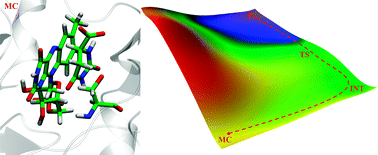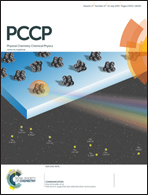Insights into the mechanism of oxidation of dihydroorotate to orotate catalysed by human class 2 dihydroorotate dehydrogenase: a QM/MM free energy study†
Abstract
The dihydroorotate dehydrogenase (DHOD) enzyme catalyzes the unique redox reaction in the de novo pyrimidine biosynthesis pathway. In this reaction, the oxidation of dihydroorotate (DHO) to orotate (OA) and reduction of the flavin mononucleotide (FMN) cofactor is catalysed by DHOD. The class 2 DHOD, to which the human enzyme belongs, was experimentally shown to follow a stepwise mechanism but the data did not allow the determination of the order of bond-breaking in a stepwise oxidation of DHO. The goal of this study is to understand the reaction mechanism at the molecular level of class 2 DHOD, which may aid in the design of inhibitors that selectively impact the activity of only certain members of the enzyme family. In this paper, the catalytic mechanism of oxidation of DHO to OA in human DHOD was studied using a hybrid Quantum Mechanical/Molecular Mechanical (QM/MM) approach and Molecular Dynamics (MD) simulations. The free energy barriers calculated reveal that the mechanism in human DHOD occurs via a stepwise reaction pathway. In the first step, a proton is abstracted from the C5 of DHO to the deprotonated Ser215 side chain. Whereas, in the second step, the transfer of the hydride or hydride equivalent from the C6 of DHO to the N5 of FMN, where free energy barrier calculated by the DFT/MM level is 10.84 kcal mol−1. Finally, a residual decomposition analysis was carried out in order to elucidate the influence of the catalytic region residues during DHO oxidation.


 Please wait while we load your content...
Please wait while we load your content...